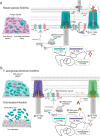Specialized killing across the domains of life by the type VI secretion systems of Pseudomonas aeruginosa
- PMID: 39774785
- PMCID: PMC12133291
- DOI: 10.1042/BCJ20230240
Specialized killing across the domains of life by the type VI secretion systems of Pseudomonas aeruginosa
Abstract
Type VI secretion systems (T6SSs) are widespread bacterial protein secretion machines that inject toxic effector proteins into nearby cells, thus facilitating both bacterial competition and virulence. Pseudomonas aeruginosa encodes three evolutionarily distinct T6SSs that each export a unique repertoire of effectors. Owing to its genetic tractability, P. aeruginosa has served as a model organism for molecular studies of the T6SS. However, P. aeruginosa is also an opportunistic pathogen and ubiquitous environmental organism that thrives in a wide range of habitats. Consequently, studies of its T6SSs have provided insight into the role these systems play in the diverse lifestyles of this species. In this review, we discuss recent advances in understanding the regulation and toxin repertoire of each of the three P. aeruginosa T6SSs. We argue that these T6SSs serve distinct physiological functions; whereas one system is a dedicated defensive weapon for interbacterial antagonism, the other two T6SSs appear to function primarily during infection. We find support for this model in examining the signalling pathways that control the expression of each T6SS and co-ordinate the activity of these systems with other P. aeruginosa behaviours. Furthermore, we discuss the effector repertoires of each T6SS and connect the mechanisms by which these effectors kill target cells to the ecological conditions under which their respective systems are activated. Understanding the T6SSs of P. aeruginosa in the context of this organism's diverse lifestyles will provide insight into the physiological roles these secretion systems play in this remarkably adaptable bacterium.
Keywords: Bacterial toxins; Pseudomonas aeruginosa; Type VI secretion systems.
© 2025 The Author(s).
Conflict of interest statement
The authors report no conflicts of interest.
Figures


Similar articles
-
PitA Controls the H2- and H3-T6SSs through PhoB in Pseudomonas aeruginosa.Appl Environ Microbiol. 2023 Jun 28;89(6):e0209422. doi: 10.1128/aem.02094-22. Epub 2023 May 15. Appl Environ Microbiol. 2023. PMID: 37184394 Free PMC article.
-
Regulation of the H1 Type VI Secretion System by the Transcriptional Regulator NfxB in Pseudomonas aeruginosa.Int J Mol Sci. 2025 Feb 10;26(4):1472. doi: 10.3390/ijms26041472. Int J Mol Sci. 2025. PMID: 40003937 Free PMC article.
-
Distribution of the four type VI secretion systems in Pseudomonas aeruginosa and classification of their core and accessory effectors.Nat Commun. 2025 Jan 21;16(1):888. doi: 10.1038/s41467-024-54649-5. Nat Commun. 2025. PMID: 39837841 Free PMC article.
-
The T6SSs of Pseudomonas aeruginosa Strain PAO1 and Their Effectors: Beyond Bacterial-Cell Targeting.Front Cell Infect Microbiol. 2016 Jun 9;6:61. doi: 10.3389/fcimb.2016.00061. eCollection 2016. Front Cell Infect Microbiol. 2016. PMID: 27376031 Free PMC article. Review.
-
Composition, function, and regulation of T6SS in Pseudomonas aeruginosa.Microbiol Res. 2015 Mar;172:19-25. doi: 10.1016/j.micres.2015.01.004. Epub 2015 Jan 7. Microbiol Res. 2015. PMID: 25721475 Review.
Cited by
-
The Negative Regulatory Role of Transcriptional Regulator H-NS on the Type VI Secretion System in Acinetobacter baumannii.Infect Drug Resist. 2025 Jun 12;18:2997-3011. doi: 10.2147/IDR.S512650. eCollection 2025. Infect Drug Resist. 2025. PMID: 40529232 Free PMC article.
-
Coordination of virulence factors and lifestyle transition in Pseudomonas aeruginosa through single-cell analysis.Commun Biol. 2025 Aug 16;8(1):1236. doi: 10.1038/s42003-025-08693-6. Commun Biol. 2025. PMID: 40819180 Free PMC article.
-
Artificial symbiont replacement in a vertically transmitted plant symbiosis reveals a role for microbe-microbe interactions in enforcing specificity.ISME J. 2025 Jan 2;19(1):wraf177. doi: 10.1093/ismejo/wraf177. ISME J. 2025. PMID: 40827673 Free PMC article.
References
Publication types
MeSH terms
Substances
LinkOut - more resources
Full Text Sources

